Visual Art: ‘Cyfoes’: Celf Cymru Heddiw/Contemporary Welsh Art
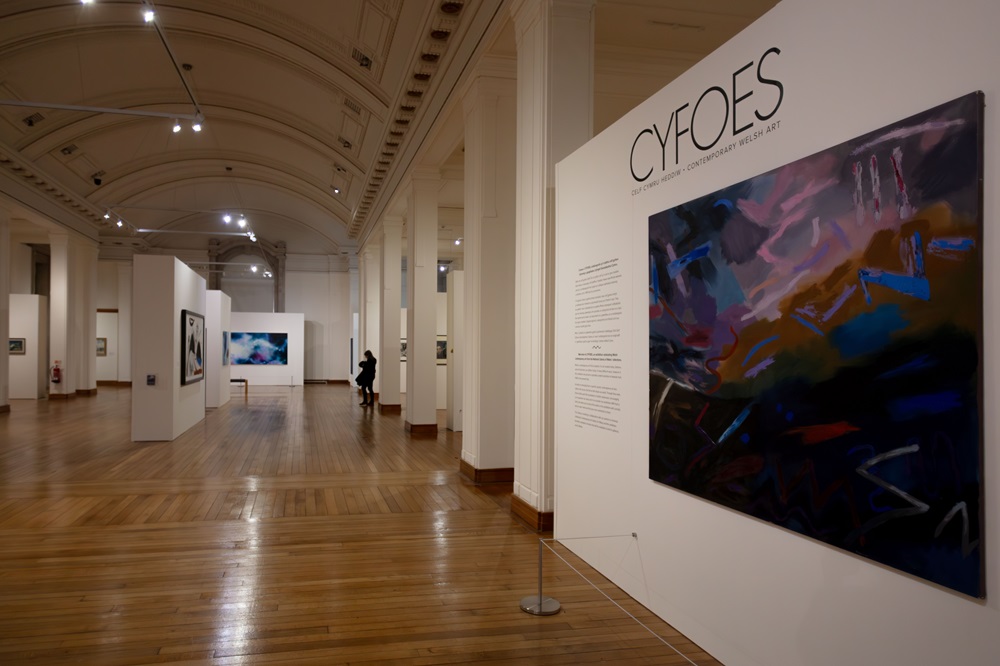
Niall Griffiths
Ah, the National Library. Bulks on the hill above Aberystwyth; broods over the town below. Kafka’s Castle without the menace, a trip inside it animates the urge to do more, write more, learn more, be more. A monument to the pursuit of knowledge and self-expansion.
Forgive the disjointedness of this piece; I’m still somewhat invigoratingly shredded after visiting the titular exhibition yesterday. It’s mighty.
The space itself is impressive – bright white, airy, columned, sepulchral. The curators – Mari Elin Jones and Morfudd Bevan – have expertly and sensitively marshalled it in deep respect for and awe of the avalanche of visual creativity contained herein.
The exhibition is divided into categories – Health and Wellbeing, Wales and Welsh Relevance, People, Society and Identity etc.
Utilised media is eclectic and innovative and judicious, kicking off with Geoff Charles’s famous image of the Tryweryn protest in Liverpool (and which was used for the cover of Wyn Thomas’s magisterial book Tryweryn:A New Dawn?) – the people and their placards dwarfed by the monstrous furniture of industrial ‘progress’.
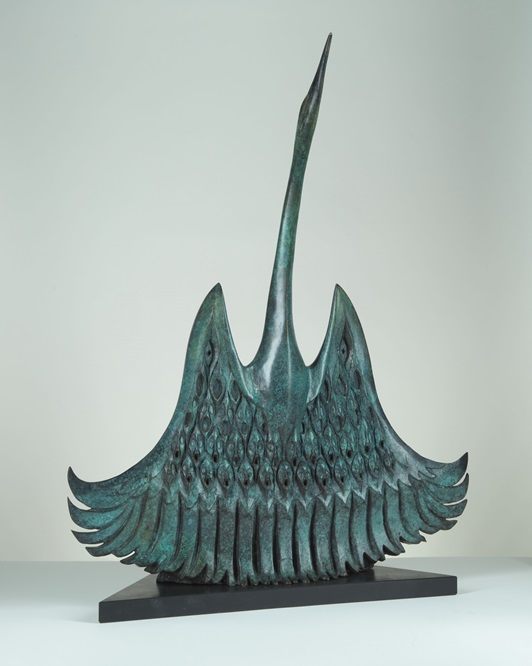
There’s John Meirion Moris’s bronze of the bird – a heron? – straining upwards towards flight; this was planned to be 30 ft tall on the shores of Llyn Celyn and what a sight that would’ve been. Lean in, look closely and you’ll see faces in the carved feathers of the spread underwings.
Shattering
Luned Rhys Parri is here, with her boxed diorama (the subject of which has been imprisoned for Welsh language activism); I find an alluring captured humour in its arrangement.
Marian Delyth has photographs of Cardiff protests in the 80s, in solidarity with the victims of a racist murder in New York.
And there is an image of John Petts’s shattering stained glass window given to the church in Birmingham, Alabama, to reflect despair at the fire-bombing, with racist intent, of that building and the loss of young lives in the flames: ‘given by the people of Wales’, says the frame.
‘You Do It To Me’ says the crucified Christ.
Climate change
And of course there are climate change concerns; Jeremy Moore’s ‘Oiled Sea Birds’ is harrowing – the turning of beauty into toxic waste. And too, there’s Industry; the uchronia of Lisa Eurgain Taylor, ‘no pylons, no roads, no sign of humanity’.
Lockdown features, as it must: Manon Awst’s short film made in 2020 illustrates the transportational and connective and anchoring powers of the creative impulse.
The crackling impurities of the celluloid, the sunlit field and beach, empty of all human life except the artist’s. ‘Every day is the same but different’ is the repeated phrase (translated from the Cymraeg).
I love the kitchen clutter and chaos stilled and arrested in Kim James-Williams’s inked kitchen. I recall my own experience of lockdown.
Fragile lives
Bedwyr Williams’s lightbox declares, white on red, ‘Artists of Integrity: Solidarity in Insincerity’, prompts laugher and reflection.
Tony Steele Morgan has a frame-within-a-frame of a ram within an industrial landscape within a bucolic one. A butterfly perches on the inner frame. Each environment encroaches upon the other.
And what discoveries there are to be found: I knew nothing of Humberto Gatica (escapee from Pinochet’s fascistic regime, settled in Swansea) before this exhibition, nor of Philip Jones Griffiths, who found affinities with the Welsh rural peasantry in the Vietnamese hill peoples and chronicled the American invasion in photographs.
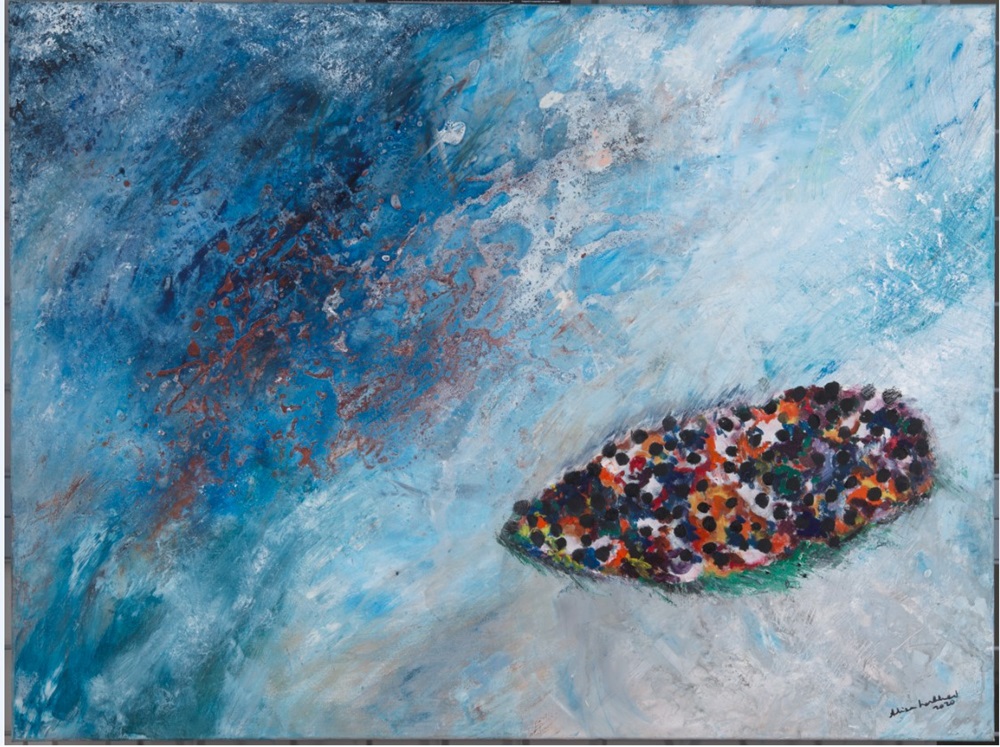
Alison Lochhead’s painting ‘Refugees All At Sea’ will knock you back on your heels; look at the fragility of their lives. The desperate vulnerabilities. The tininess of them and the flimsiness of their vessel in the indifferent expanse of the ocean.
I am reminded of a passion fruit or dragon fruit, bisected; the tops of their heads have become seeds.
There are familiar names too, of course – Iwan Bala, Kyffin Williams (the scale of his canvas took me aback somewhat).
Bala’s ‘Figure in a Landscape: Haunted by Ancient Gods’ pulses with lived myth from Wales, Africa, South America; you’re prompted to consider the connections between various ‘primitivisms’, and the possibility of ur-experience, ur-dream. Abbie Trayler-Smith’s photograph ‘Fleeing Mosul’ throbs with poignancy; the rain, the face, the glass.
Simplicity
Nicholas Evans’s ‘Soup Kitchen’ has the colliers hunched and huddled and hungry and decidedly unheroic. The abstract landscapes that follow are a visual rush of exhilaration.
Natalie Chapman’s take on ‘Me Too’ strikes in the poignancy of its simplicity. Clive Hicks Jenkins’s ‘Deposition III’ is a take on the Mari Llwyd and is breathtaking: oneiric, hallucinatory, beautiful, terrifying (I get echoes of Fuseli and ‘Guernica’).
What power there is here, enclosed in the Gregynog Gallery. It hums.
Gwenno Llwyd Till’s film ‘Pwy wyt ti?’ is a compressed self-portrait that encapsulates the yearning for identity through belonging.
There are expressions of the self through the prism of immigrant experience – Trinidad, Ghana. Sculpture, gouache, film, oil, watercolour.
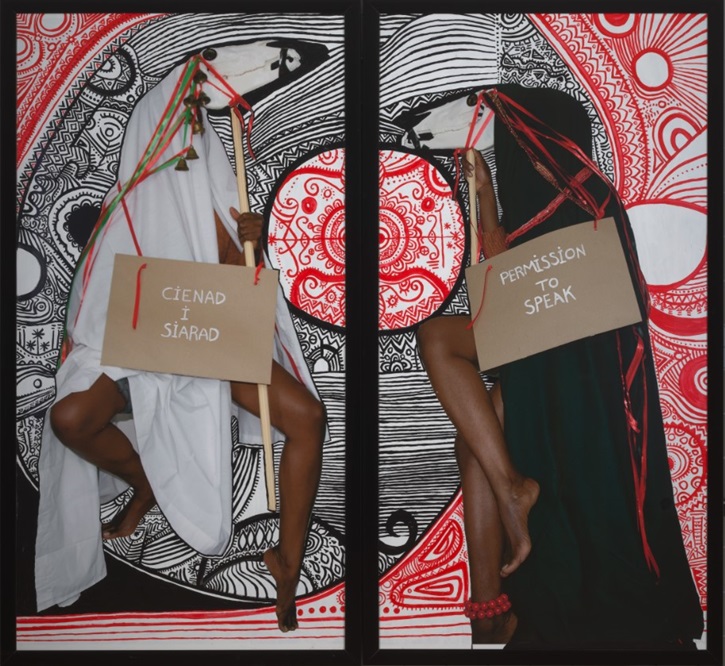
Adoption
The Mabinogion features, as well it might: John Elwyn’s ‘Birds of Rhiannon’ is incandescent, opalescent.
I could write more, and praise more, but here I must jump to the end, and Mary Husted’s twin boxes (‘Hush, Don’t Tell’ and ‘Rock a Bye’) which actually made me gasp and search my pockets for my glasses only to realise they were on my face.
Pencil on acetate film with cellophane in perspex boxes, these are wispy, whispering portraits of the baby the artist spent ten days with, at seventeen, before giving him up for adoption (family pressures) and they will haunt me forever; their ephemerality, their spectral qualities, do, and please forgive the cliché, wrench the heart; I mean, an invisible hand reaches into your diaphragm and clasps the organ and gives it a yank. And then yanks it again.
They are an emotional experience to witness. A profoundly intense one.
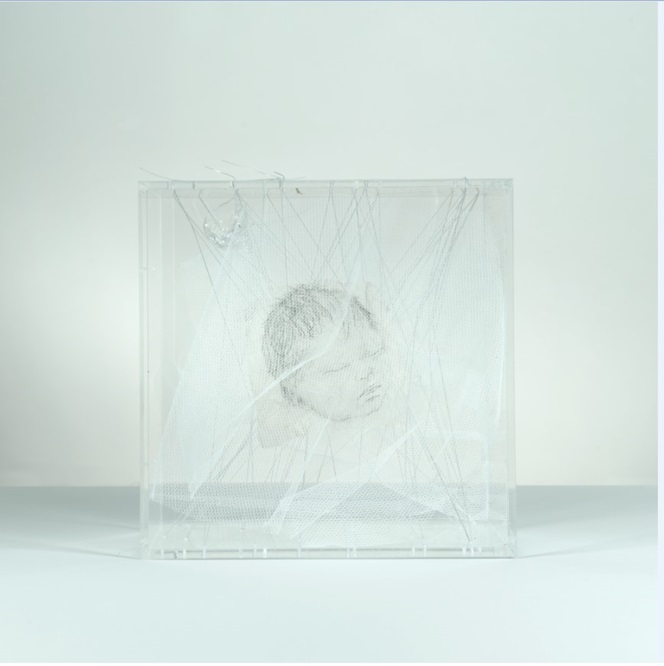
‘Cyfoes’: Celf Cymru Heddiw/Contemporary Welsh Art runs at the National Library, Aberystwyth until March 23rd.
Support our Nation today
For the price of a cup of coffee a month you can help us create an independent, not-for-profit, national news service for the people of Wales, by the people of Wales.







Wish it would tour to Cardiff – and elsewhere. Any chance?